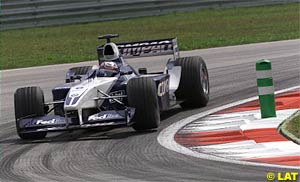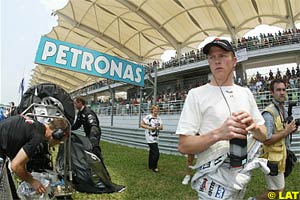
Atlas F1 Senior Writer
The Malaysian Grand Prix provided good racing, lots of overtaking and, as usual, some controversy. Roger Horton returns from the Sepang paddock with insights from the second race of the 2002 season
Once again we had drama at the start of the race. Michael Schumacher made his now ritualistic move across the track to block his fellow front row starter, which as a blocking move has now become pretty ineffective because it has become so predictable. Juan Pablo Montoya just drove around him and the superior acceleration of his Williams did the rest. Montoya also looked to be moving just a fraction before Michael, and it was just as well, because Rubens Barrichello had made a flyer from the second row and they were all three abreast entering the braking zone for the first corner.
The steward's decision that Montoya had caused 'an avoidable accident', and the punishment that was to be the newly instituted drive-through penalty, looked to be harsh in the extreme. There are just too many examples of similar incidents that have gone totally unpunished for the decision to have any credibility. The decision was a mistake, pure and simple, and the sooner the FIA constitute a more even-handed method of dishing out penalties the better.
Despite Montoya's rather macho image, the Colombian has had a pretty good record of avoiding contact with other cars, especially given the number of ballsy overtaking manoeuvres he executes. In this instance, the two drivers who are almost certainly going to be fighting it out for this year's Championship were doing what they get paid millions to do: driving on the limit and entertaining us all, but for some reason race control didn't see it that way.
So what effect did the incident have on each protagonist? Certainly the contact seemed to take the edge off Schumacher's car, and although he made it back onto the podium, his speed was not overly impressive throughout the race. Certainly it leaves a major question mark over whether he could have beaten a two-stopping Montoya, and one feels that Ferrari might now need their new F2002 sooner rather than later.
For Montoya, the incident was actually a triple whammy, and it effectively ended his hopes of victory as soon as he fell behind his teammate on that first lap. The Williams team knew from their simulations that two stopping around Sepang was about eight seconds faster than a one stop routine, which is why Montoya, who was ahead of Ralf on the grid, was given the faster option.
Provided the Colombian had got away cleanly at the start, the two teammates would not have been on conflicting strategies with the need for one to yield to the other. Once Ralf was ahead, however, Montoya would have faced the prospect of passing his teammate, which would have been next to impossible to achieve.
For good measure, an aero fin in front of Montoya's right hand bargeboard was also damaged, and Sam Michael, Williams's operational chief, estimated that the damage was worth at least four tenths of a second per lap. Add to that the drive-through penalty, which he took on lap nine, and which cost him some twenty seconds, and you can see why he ended up pretty pleased with a second place finish, but mad about receiving the penalty.
In an age when there is so much talk about the lack of overtaking in Formula One, it is worth noting Montoya's progress throughout this race.
So not counting passes made in the pits or cars that were slowing due to mechanical problems and lapped cars, he made ten overtaking manoeuvres during the race, added, it must be said, by loads of BMW power and a well-designed track.
David Coulthard and Jenson Button suffered totally contrasting fortunes in Malaysia. Already, after just two races Coulthard's season is looking a real mess, and yet the Scot is completely blameless and once again it is McLaren - or should that be Mercedes - that is letting him down. Already the media are piling on the pressure and Coulthard was feeling the heat, literally, as he tried to remain positive in the face of his car's appalling reliability.
Then, moments later, out of the McLaren garage steps a showered and changed Kimi Raikkonen, looking as cool as you like. He mumbled a few words about his car's balance and disappeared back into his air-conditioned sanctuary leaving behind an impression of a young driver totally in control and wondering what all the fuss is about. No wonder even Ron Dennis thinks he is an exceptional cool customer, because he is, and in Malaysia he looked to be pretty quick too. At the end of the day, Raikkonen has time on his side at McLaren and Coulthard does not.
Jenson Button on the other hand, is bouncing back strongly from the difficulties of last year and in Malaysia his Renault looked sublime through the fast corners, and efficient out of the slow ones. He qualified eighth in the spare car in only two runs and in the race he was fast and consistent, and no wonder the team has an air of confidence about them.
"He had a difficult year with us last year with a difficult car, fitting into a new team and everything", said Renault Director of Engineering Pat Symonds of Button, after he had narrowly missed out on his first ever podium finish when his suspension failed only two laps from the end. "He fits into the team extremely well now, he has done well over the winter, he is supremely fit, and he is really applying himself. The Jenson that was always there we have managed to expose again. Maybe we buried him a bit last year."
Symonds, though, a ten-year veteran with the Benetton/Renault concern, and a man who won three Championships with Michael Schumacher was typically laid back despite their improving form. "I only celebrate third and above" he said, as he observed the fuss surrounding Button's return to the paddock after his fourth place finish.
So in the end, all the hard work that Williams BMW put in over the winter paid off for the Grove based outfit. So far, they are one of only two teams not to have suffered a mechanical failure in a race this year, a product of the over 21 thousand kilometres of testing that the team and their four drivers carried out between the new year and the first race in Melbourne.
A case of the harder you work the luckier you get perhaps, but as the champagne was opened and a first one/two result ever for BMW in Grand Prix racing was entering the history books, the only man missing from the celebrations was the team's founder Frank Williams. By half distance he was gone from the circuit and already flying away, but fortunately for Frank his cars were flying too, and no one could catch them.
The battle for the 2002 titles really started at this Malaysian Grand Prix. We had three days of extremely hot, but consistent weather conditions, so the teams were essentially left with nowhere to hide; those who were quick had the opportunity to show it, and the rest had no excuses.
 What happened next was considered by just about everyone in the paddock I encountered to be a pure racing accident. Montoya lent on Schumacher through the right handed turn one because he needed to ensure he had the inside line for the following left-hander, turn two. Michael drifted a little wide and the two made hard enough contact to dislodge the Ferrari's front wing and for Montoya to momentarily leave the track on the outside.
What happened next was considered by just about everyone in the paddock I encountered to be a pure racing accident. Montoya lent on Schumacher through the right handed turn one because he needed to ensure he had the inside line for the following left-hander, turn two. Michael drifted a little wide and the two made hard enough contact to dislodge the Ferrari's front wing and for Montoya to momentarily leave the track on the outside.
Lap 1. Briefly in the lead, then down to thirteenth position after his off-track excursion. He re-passes Enrique Bernoldi and Felipe Massa before the end of the lap and is eleventh across the line.
Lap 2. Ninth. Passes the two Jordans, which have collided with each other.
Lap 3. Seventh. Passes Mika Salo and Jarno Trulli.
Lap 7. Sixth. Passes Jenson Button for the first time.
Lap 10. Ninth again after drive-through penalty.
Lap 15. Seventh. Passes Allan McNish and a slowing David Coulthard.
Lap 20. Fifth. Passes Mika Salo again, and Heidfeld (in the pits).
Lap 21. Pits. Rejoins in sixth.
Lap 25. Fifth. Passes Mika Salo (in the pits).
Lap 27. Fourth. Passes Heidfeld again.
Lap 32. Third. Passes Button for the second time.
Lap 39. Pits for the second time. Rejoins in fourth.
Lap 41. Third. Passes Michael Schumacher (in the pits).
Lap 44. Second. Passes Jenson Button for the third time.
Lap 56. Finishes second.
 Sometimes perceptions can be more powerful than reality, and after being outqualified by his young teammate, Coulthard faced the media for the inevitable post mortem. Bathed in sweat and no doubt wishing he could be somewhere else, he patiently explained his car's problems and why it was only good enough for sixth on the grid. He looked and sounded like a driver doing exactly what he was: putting a brave face on a difficult situation and not really convincing anyone.
Sometimes perceptions can be more powerful than reality, and after being outqualified by his young teammate, Coulthard faced the media for the inevitable post mortem. Bathed in sweat and no doubt wishing he could be somewhere else, he patiently explained his car's problems and why it was only good enough for sixth on the grid. He looked and sounded like a driver doing exactly what he was: putting a brave face on a difficult situation and not really convincing anyone.
Please Contact Us for permission to republish this or any other material from Atlas F1.
|
Volume 8, Issue 12
Atlas F1 Exclusive
Stoddart's Roller Coaster Ride
The Man Who Follows the Money
In the Spotlight: Tyre War, Tyre War
Malaysian GP Review
The Malaysian GP Review
Technical Review: Malaysian GP
Commentary
The Setting Sun
Reflections from Sepang
Seconds Out
Stats
Qualifying Differentials
SuperStats
Charts Center
Columns
Season Strokes
Elsewhere in Racing
The Grapevine
> Homepage |